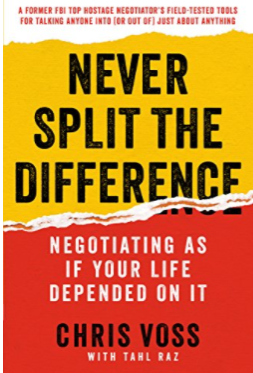The autonomy-affirming power of “No”
It’s counterintuitive, but it works. Indeed, the recommendation to strive for “No,” not “Yes,” when negotiating is one of the tenets of master negotiator Chris Voss.
You may have seen Chris Voss being interviewed on cable news or seen ads for his Masterclass. He’s a former FBI hostage negotiator. His book, Never Split the Difference, teaches you how to get what you want when negotiating. It is one of the most important books you will ever read.
In just a couple of weeks, by using the tips Voss advocates I have been able to more easily get what I want. It’s not about bulldozing over your negotiating partner (whether that’s your spouse, child, business associate, or local auto dealer). It’s about using empathy, body language, and word choice, among many other things, so that the other party naturally goes where you want them to go. It’s mainly about LISTENING.
What does all this have to do with writing? Writers are often introverted, insular, and internally focused. It’s hard for some of us to get out of our comfort zone. And when we find ourselves in the middle of a negotiation, or, even worse, a haggle, we (and many other people) experience fight or flight. But we don’t need to fear it. (You can also work these tips into your stories!)
Over the next couple of weeks, I’m going to share with you a few of Voss’ main rules. One of the most important is to strive for the other party to tell you “No” rather than “Yes” at the beginning of a negotiation.
When the other party says “No,” that begins the negotiation; it doesn’t end it. When someone says “No” to your request, they are protecting their boundaries and independence. After they’ve done that, they relax and are more apt to listen to what you have to say.
Voss noticed that after he told his son “No,” he was more willing to listen to what his son had to say and be willing to change his position.
We’ve been conditioned to fear the word “No.” But it is a statement of perception far more often than of fact. It seldom means ‘I have considered all the facts and made a rational choice.’ Instead, “No” is often a decision…to maintain the status quo. Change is scary, and “No” provides a little protection from that scariness.”
Chris Voss
Voss explains: When someone tells you “No,” don’t think of it as an outright rejection. Instead, think of it in one of these alternative ways:
- I am not yet ready to agree.
- You are making me feel uncomfortable.
- I don’t understand.
- I don’t think I can afford it.
- I want something else.
- I need more information.
- I want to talk it over with someone else.
“No” is autonomy-affirming. When you hear it, instead of becoming agitated, ask the other person a question such as, “What about this doesn’t work for you? Or, “You seem to be a little uncomfortable.” Or, “What would you need in order for this to happen?” Or, “What would you need in order to feel comfortable about this?”
All of the above questions Voss recommends invite explanation and allow the real issues to be unearthed.
Using this technique when parenting
This technique also works when parenting older children. How often have you heard a parent say, “Don’t you dare say “No” to me!” after his child has told him “No.” I have a big moral problem with this response. As children grow older, they experiment with their increasing independence. They naturally experiment first in the safest space they know, at home with the parents (hopefully home is a safe space). If the parent responds angrily when the child says “No,” and does not allow the child to say “No,” then the child learns to comply without question and that his preferences do not matter. That tendency sets the child up to be an adult who is easily taken advantage of and walked all over. In other words, it sets the child up to become an adult with poor boundaries, which is not a healthy way to live.
We want our children to be open with us. They should be able to tell us anything, including “No,” as long as they are civil and respectful.
Instead, view your child saying “No” to you as a way for you to invite him to explain further and to get to the real issues.
Here’s a recent example when I tried this with my son:
Me: Okay, we’re taking a screen break. Let’s exercise for 30 minutes.
Son: No, no (shakes head vigorously). I’m sorry, Mom. I’m not exercising today. We exercised yesterday.
Me: Well, actually we exercised the day before yesterday. Today is Thursday.
Son: (ponders) Oh, yeah; we exercised the day before yesterday.
Me: Well, I need to exercise. I’m going to do my video.
Son: I want to do my own exercises.
Me: Sure that’s fine.
Son: I’m going to set the timer for 30 minutes and jog in place and do jumping jacks.
Me: Sure. Go ahead.
He proceeded to exercise with no problem.
See how easy this was? And I didn’t even have to ask him any follow-up questions!
So the next time someone tells you “No,” be silent for a few seconds and ask a gentle follow-up question as recommended by Voss. See what happens. I bet you’ll be surprised.
I’ll have more negotiation tips next week!
Get helpful writing tips and more
in your inbox
Join the tribe and get free fiction and self-publishing tips.
Thank you for subscribing.
Something went wrong.


[…] time we talked about how you should not be unsettled when the other party says “No.” “No” usually means that the other person is protecting his autonomy and that he […]